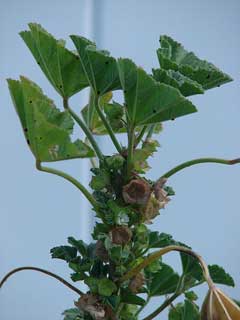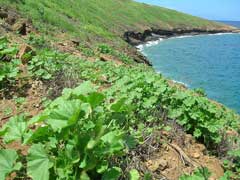 |
|
http://www.hear.org/starr/ |
 |
| http://www.hear.org/starr/ |
Translate this page:
Summary
Physical Characteristics

 Malva parviflora is a ANNUAL growing to 0.5 m (1ft 8in).
Malva parviflora is a ANNUAL growing to 0.5 m (1ft 8in).
It is not frost tender. The species is hermaphrodite (has both male and female organs) and is pollinated by Insects.
Suitable for: light (sandy), medium (loamy) and heavy (clay) soils and prefers well-drained soil. Suitable pH: mildly acid, neutral and basic (mildly alkaline) soils. It can grow in semi-shade (light woodland) or no shade. It prefers moist soil.
UK Hardiness Map
US Hardiness Map
Synonyms
Plant Habitats
Cultivated Beds;
Edible Uses
Edible Parts: Leaves Oil Seed
Edible Uses: Oil
Leaves - raw or cooked as a potherb[61, 114, 183]. A mild pleasant flavour, they make a very acceptable alternative to lettuce in salads[K]. Immature seeds - raw or cooked[114, 183]. They are used to make a creamed vegetable soup that resembles pea soup[183]. A few leaves are also added for colouring[183]. The seeds have a pleasant nutty flavour, though they are too small for most people to want to collect in quantity[K].
References More on Edible Uses
Medicinal Uses
Plants For A Future can not take any responsibility for any adverse effects from the use of plants. Always seek advice from a professional before using a plant medicinally.
Antidandruff Demulcent Emollient Pectoral Skin
The whole plant is emollient and pectoral[114, 240]. It can be used as a poultice on swellings, running sores and boils[257]. The seeds are demulcent[240]. They are used in the treatment of coughs and ulcers in the bladder[240]. A decoction of the roots or leaves has been used as a hair rinse to remove dandruff and to soften the hair[257].
References More on Medicinal Uses
The Bookshop: Edible Plant Books
Our Latest books on Perennial Plants For Food Forests and Permaculture Gardens in paperback or digital formats.

Edible Tropical Plants
Food Forest Plants for Hotter Conditions: 250+ Plants For Tropical Food Forests & Permaculture Gardens.
More

Edible Temperate Plants
Plants for Your Food Forest: 500 Plants for Temperate Food Forests & Permaculture Gardens.
More

More Books
PFAF have eight books available in paperback and digital formats. Browse the shop for more information.
Shop Now
Other Uses
Dye Hair Oil
The seed contains up to 18% of a fatty oil[114]. No more details are given, though the oil is likely to be edible[K]. Cream, yellow and green dyes can be obtained from the plant and the seed heads[168]. A decoction of the roots or leaves has been used as a hair rinse to soften the hair[257].
Special Uses
References More on Other Uses
Cultivation details
A very easily grown plant, succeeding in ordinary garden soil[1], though it prefers a reasonably well-drained and moderately fertile soil in a sunny position[200]. Plants seem to be immune to the predations of rabbits[233]. Plants are prone to infestation by rust fungus[200].
References Carbon Farming Information and Carbon Sequestration Information
Temperature Converter
Type a value in the Celsius field to convert the value to Fahrenheit:
Fahrenheit:
The PFAF Bookshop
Plants For A Future have a number of books available in paperback and digital form. Book titles include Edible Plants, Edible Perennials, Edible Trees,Edible Shrubs, Woodland Gardening, and Temperate Food Forest Plants. Our new book is Food Forest Plants For Hotter Conditions (Tropical and Sub-Tropical).
Shop Now
Plant Propagation
Seed - sow early spring in situ. Germination should take place within 2 weeks.
Other Names
If available other names are mentioned here
Native Range
TEMPERATE ASIA: Kuwait, Afghanistan, Cyprus, Egypt (Sinai), Iran, Israel, Jordan, Lebanon, Syria, Turkey, Armenia, Azerbaijan, Turkmenistan EUROPE: Albania, Bosnia and Herzegovina, Greece, Croatia, Italy, Malta, Spain (incl. Baleares), France, Portugal AFRICA: Algeria, Egypt, Libya, Morocco, Tunisia
Weed Potential
Right plant wrong place. We are currently updating this section.
Please note that a plant may be invasive in one area but may not in your area so it's worth checking.
Conservation Status
IUCN Red List of Threatened Plants Status :

| Related Plants
|
| Latin Name | Common Name | Habit | Height | Hardiness | Growth | Soil | Shade | Moisture | Edible | Medicinal | Other |
| Abelmoschus esculentus | Okra | Annual | 1.0 |
5-11
| | LMH | N | M | 4 | 3 | 2 |
| Abelmoschus manihot | Aibika | Perennial | 3.0 |
8-11
| F | LMH | N | M | 4 | 1 | 2 |
| Abelmoschus moschatus | Musk Mallow,Musk Okra | Perennial | 2.0 |
8-11
| F | LMH | N | M | 2 | 3 | 3 |
| Abroma augusta | Cotton Abroma. Perennial Indian Hemp. | Shrub | 3.0 |
10-12
| F | LMH | N | M | 0 | 3 | 4 |
| Abutilon megapotamicum | Trailing Abutilon | Shrub | 2.0 |
7-10
| F | LMH | SN | M | 4 | 0 | 0 |
| Abutilon ochsenii | | Shrub | 4.0 |
7-10
| | LMH | SN | M | 3 | 0 | |
| Abutilon pictum | Abutilon, Parlour Maple, Flowering Maple, Spotted | Shrub | 5.0 |
8-10
| M | LMH | SN | M | 3 | 0 | |
| Abutilon purpurascens | | Shrub | 2.4 |
8-11
| | LMH | SN | DM | 2 | 0 | |
| Abutilon species | | Shrub | 3.0 |
7-10
| | LMH | SN | M | 3 | 0 | |
| Abutilon theophrasti | China Jute, Velvetleaf, Butterprint Buttonweed Jute, China Mallow, Indian Velvet Leaf | Annual | 1.0 |
0-0
| | LMH | SN | DM | 3 | 2 | 4 |
| Abutilon vitifolium | | Shrub | 8.0 |
7-10
| | LMH | SN | M | 3 | 0 | |
| Abutilon x hybridum | Chinese Lantern, Flowering Maple | Shrub | 3.0 |
9-11
| F | LMH | SN | M | 3 | 0 | 0 |
| Abutilon x milleri | Trailing Abutilon | Shrub | 3.0 |
7-10
| | LMH | SN | M | 3 | 0 | |
| Abutilon x suntense | | Shrub | 8.0 |
7-10
| F | LMH | SN | M | 3 | 0 | |
| Adansonia digitata | Baobab, Judas Fruit, Monkey Bread Tree | Tree | 20.0 |
10-12
| S | LMH | N | DM | 3 | 3 | 4 |
| Alcea rosea | Hollyhock | Perennial | 2.4 |
5-9
| F | LMH | N | DM | 3 | 2 | 3 |
| Althaea cannabina | Palm-leaf marshmallow | Perennial | 1.8 |
4-8
| | LMH | N | DM | 0 | 0 | 1 |
| Althaea officinalis | Marsh Mallow, Common marshmallow | Perennial | 1.2 |
3-7
| M | LMH | N | DM | 5 | 5 | 3 |
| Anoda cristata | Crested Anoda | Annual | 0.8 |
8-11
| F | LMH | N | DM | 2 | 0 | 0 |
| Bombax ceiba | Red Silk Cotton Tree, Kapok Tree | Tree | 25.0 |
10-12
| M | LMH | N | DM | 2 | 2 | 4 |
| Burretiodendron hsienmu | Hsienmu wood | Tree | 35.0 |
10-12
| S | LMH | N | M | 0 | 0 | 4 |
| Callirhoe digitata | Finger Poppy Mallow, Winecup | Perennial | 0.9 |
4-8
| | L | N | DM | 2 | 0 | |
| Callirhoe involucrata | Poppy Mallow, Purple poppymallow, Winecup, Finger Poppy Mallow | Perennial | 0.2 |
4-8
| M | L | N | DM | 3 | 2 | 0 |
| Callirhoe leiocarpa | Tall Poppy-Mallow | Annual | 0.9 |
5-9
| | L | N | DM | 2 | 0 | |
| Ceiba aesculifolia | Pochote | Tree | 25.0 |
10-12
| M | LMH | N | DM | 2 | 1 | 4 |
| Ceiba pentandra | Kapok Tree, Cotton Tree, Suma'ma | Tree | 50.0 |
10-12
| F | MH | N | DM | 3 | 3 | 5 |
| Clappertonia ficifolia | Bolo Bolo | Shrub | 2.5 |
10-12
| F | LM | N | MWe | 0 | 1 | 4 |
| Cola acuminata | Cola Nut, Kola, Bissy Nut | Tree | 20.0 |
10-12
| M | LMH | N | M | 3 | 4 | 2 |
| Cola nitida | Cola Nut, Kola, Bissy Nuts | Tree | 20.0 |
10-12
| S | LMH | SN | DM | 3 | 4 | 2 |
| Durio dulcis | Durian Marangang, Merangang, Red Durian, Tutong, Lahong | Tree | 30.0 |
11-12
| M | LMH | N | M | 4 | 0 | 2 |
|
|
Growth: S = slow M = medium F = fast. Soil: L = light (sandy) M = medium H = heavy (clay). pH: A = acid N = neutral B = basic (alkaline). Shade: F = full shade S = semi-shade N = no shade. Moisture: D = dry M = Moist We = wet Wa = water.
Now available:
Food Forest Plants for Mediterranean Conditions
350+ Perennial Plants For Mediterranean and Drier Food Forests and Permaculture Gardens.
[Paperback and eBook]
This is the third in Plants For A Future's series of plant guides for food forests tailored to
specific climate zones. Following volumes on temperate and tropical ecosystems, this book focuses
on species suited to Mediterranean conditions—regions with hot, dry summers and cool, wet winters,
often facing the added challenge of climate change.
Read More
Expert comment
Author
L.
Botanical References
50
Links / References
For a list of references used on this page please go here
Readers comment